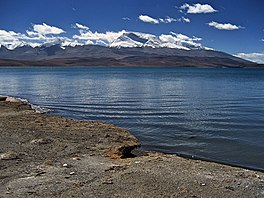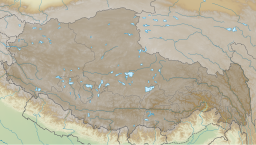geo.wikisort.org - Reservoir
Lake Rakshastal (Tibetan: ལག་ངར་མཚོ;Sanskrit: राक्षसताल; Chinese: 拉昂错) is a saltwater lake in Tibet Autonomous Region, China, lying just west of Lake Manasarovar and south of Mount Kailash.[1][2] The Sutlej River (also known by the Tibetan name Langqen Zangbo in this area) originates at Rakshastal's northwestern tip.
| Lake Rakshastal | |
|---|---|
 View South from Rakshas Tal Lake (2006) | |
 Lake Rakshastal | |
| Location | Tibet Autonomous Region, |
| Coordinates | 30.65°N 81.25°E |
| Lagngar Co | |||||||
|---|---|---|---|---|---|---|---|
| Chinese name | |||||||
| Traditional Chinese | 拉昂錯 | ||||||
| Simplified Chinese | 拉昂错 | ||||||
| |||||||
| Alternative Chinese name | |||||||
| Traditional Chinese | 蘭嘎錯 | ||||||
| Simplified Chinese | 兰嘎错 | ||||||
| |||||||
| Tibetan name | |||||||
| Tibetan | ལག་ངར་མཚོ | ||||||
| |||||||
Etymology
The name of the lake literally means "lake of the demon" in Sanskrit. It is also known as Ravan Tal, as it is considered to be the place of severe penance by Ravan, the demon-like King of Lanka.[3]
In Buddhism, Lake Manasarovar, which is round like the sun, and Rakshastal, shaped as a crescent, are respectively regarded as "brightness" and "darkness". Rakshastal is a saline lake. There is a short river named Ganga Chhu, which connects Lake Manasarovar with Rakshastal, believed to be created by rishis to add pure water from Manasarovar.
There are four islands in Rakshastal, named Topserma (Dose), Dola (the two biggest), Lachato (Nadzhado), and Dosharba.[4] The islands are used by local people as winter pastures for their yaks.
In the Tibetan language, the lake is known as Lagngar Cho or Lhanag Tso, which means "the dark lake of poison".
Religious significance
According to Hindu scriptures, Rakshastal was created by Ravana for the express purpose of garnering superpowers through acts of devotion and meditation to the god, Shiva, who resided on Mount Kailash. It was upon the banks of a special island in this lake that he would make a daily offering with one of his ten heads as a sacrifice to please Shiva. Finally, on the tenth day, Shiva was moved enough by his devotion to grant Ravana his wish to obtain superpowers.
As there are no plants or wildlife around the lake, its lifeless surroundings caused the Tibetans to refer it as "the Ghost Lake". Visitors who approach the lake must be respectful to avoid inauspicious mishaps.[5]
Geography
Rakshastal covers a total area of 250 square kilometres (97 sq mi), at an altitude of 4,575 metres (15,010 ft). Though absent of nearby grasslands, the white cobbles, the hills and the island colored with dark red, and the deep blue lake water present another distinctive picture absent from many of the places more frequented by visitors. In 2004, Lake Manasarovar and Rakshastal were designated as a single Ramsar Wetland complex, under the name 'Mapangyong Cuo'.[6]
Access
Lake Rakshartal lies right next to Lake Manasarovar, and is an integral part of the Kailash-Manasarovar pilgrimage. For knowing how to reach Lake Rakshastal, see the 'Access' section on the Mount Kailash page.
Climate
| Climate data for Lake Rakshastal | |||||||||||||
|---|---|---|---|---|---|---|---|---|---|---|---|---|---|
| Month | Jan | Feb | Mar | Apr | May | Jun | Jul | Aug | Sep | Oct | Nov | Dec | Year |
| Average high °C (°F) | −2.7 (27.1) |
−1.5 (29.3) |
1.3 (34.3) |
6.7 (44.1) |
10.5 (50.9) |
13.7 (56.7) |
13.6 (56.5) |
13.1 (55.6) |
11.1 (52.0) |
6.6 (43.9) |
1.5 (34.7) |
−0.8 (30.6) |
6.1 (43.0) |
| Daily mean °C (°F) | −8.2 (17.2) |
−6.9 (19.6) |
−3.7 (25.3) |
0.3 (32.5) |
3.5 (38.3) |
7.3 (45.1) |
8.5 (47.3) |
8.2 (46.8) |
5.6 (42.1) |
0.2 (32.4) |
−4.5 (23.9) |
−6.6 (20.1) |
0.3 (32.6) |
| Average low °C (°F) | −13.6 (7.5) |
−12.3 (9.9) |
−8.6 (16.5) |
−6.0 (21.2) |
−3.4 (25.9) |
1.0 (33.8) |
3.4 (38.1) |
3.3 (37.9) |
0.1 (32.2) |
−6.2 (20.8) |
−10.4 (13.3) |
−12.4 (9.7) |
−5.4 (22.2) |
| Average precipitation mm (inches) | 58 (2.3) |
39 (1.5) |
58 (2.3) |
34 (1.3) |
29 (1.1) |
46 (1.8) |
142 (5.6) |
152 (6.0) |
76 (3.0) |
32 (1.3) |
8 (0.3) |
20 (0.8) |
694 (27.3) |
| Source: Climate-Data.org | |||||||||||||
See also
- Lake Manasarovar
- Mount Kailash
- Lakes of India
References
- Taruna Vijaya (2001). Kailash Manasarovar, an odyssey in Tibet. Ritwik Prakashan. p. 58. ISBN 9788190057127. Retrieved 2012-07-24.
- Lhanag Tso(The Ghost Lake), Ngari Tourist Sights, Tibet Travel.Info
- Pradeep Chamaria (1996). Kailash Manasarovar on the Rugged Road to Revelation. Abhinav Publications. p. 67. ISBN 978-81-7017-336-6. Retrieved 2012-07-24.
- "Kailash 2010 | Kailash". Archived from the original on 2010-11-05. Retrieved 2010-10-11.
- Lhanag Tso(The Ghost Lake), Ngari Tourist Sights, Tibet Travel.Info
- Bubriski, Kevin; Pandey, Abhimanyu (2018). Kailash Yatra: a Long Walk to Mt Kailash through Humla. New Delhi: Penguin Random House. p. 135.
На других языках
[de] Rakshastal
Rakshastal (oder Rakshas Tal; tibetisch: La'nga Co, .mw-parser-output .Tibt.uchen{font-family:"Qomolangma-Dunhuang","Qomolangma-Uchen Sarchen","Qomolangma-Uchen Sarchung","Qomolangma-Uchen Suring","Qomolangma-Uchen Sutung","Qomolangma-Title","Qomolangma-Subtitle","Qomolangma-Woodblock","DDC Uchen","DDC Rinzin","Kailash","BabelStone Tibetan","Jomolhari","TCRC Youtso Unicode","Tibetan Machine Uni","Wangdi29","Noto Sans Tibetan","Microsoft Himalaya"}.mw-parser-output .Tibt.ume{font-family:"Qomolangma-Betsu","Qomolangma-Chuyig","Qomolangma-Drutsa","Qomolangma-Edict","Qomolangma-Tsumachu","Qomolangma-Tsuring","Qomolangma-Tsutong","TibetanSambhotaYigchung","TibetanTsugRing","TibetanYigchung"}.mw-parser-output .Tibt{font-size:140%}ལག་ངར་མཚོ, Umschrift nach Wylie: lag ngar mtsho; chinesisch .mw-parser-output .Hani{font-size:110%}拉昂错, Pinyin Lā'áng Cuò) ist ein See in Autonomes Gebiet Tibet, China westlich des Sees Manasarovar und südlich des Berges Kailash. Der Fluss Satluj entspringt an der Nordwestecke des Rakshastal.- [en] Lake Rakshastal
[fr] Lac Rakshastal
Le lac Rakshastal (tibétain : ལག་ངར་མཚོ།, Wylie : lag ngar mtsho, THL : Langha-tso ; chinois simplifié : 拉昂错 ; pinyin : lā'áng cuò) est un lac situé dans la région autonome du Tibet dans la préfecture de Ngari en République populaire de Chine.[it] Lago Rakshastal
Il lago Rakshastal (tibetano: La'nga Co; "lago del Demone") è un lago tibetano poco ad ovest del lago Manasarovar. Comunica col vicino lago tramite il canale naturale Ganga Chu. Entrambi si trovano ai piedi del monte Kailash. Il fiume Sutlej nasce a nord-ovest del lago.[ru] Ланга-Цо
Ланга́-Цо[1][2], Ла́нгак[2], Ра́кас[3] (тиб. ལག་ངར་མཚོ, lag ngar mtsho, кит. упр. 拉昂错, пиньинь Lā'áng Cuò) — солоноватое озеро на юго-западе Тибетского нагорья в Китае, расположенное рядом с горой Кангринбоче (Кайлас) и озером Мапам-Юмцо. Находится на высоте 4541 м, имеет длину 28 км, ширину до 14 км и площадь около 360 км².[источник не указан 99 дней]Другой контент может иметь иную лицензию. Перед использованием материалов сайта WikiSort.org внимательно изучите правила лицензирования конкретных элементов наполнения сайта.
WikiSort.org - проект по пересортировке и дополнению контента Википедии